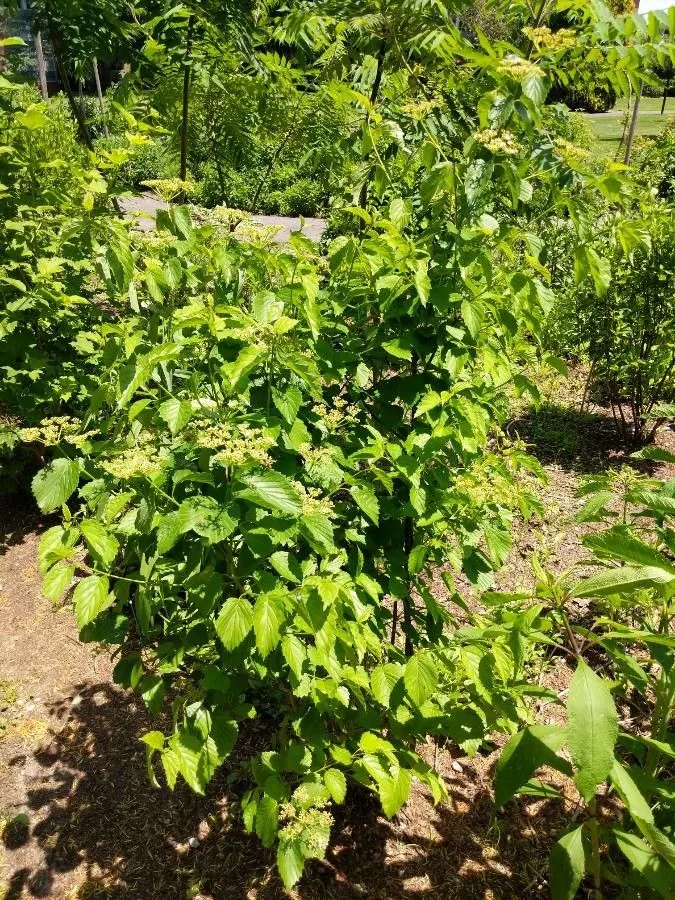
Author: L.
Bibliography: Sp. Pl.: 268 (1753)
Year: 1753
Status: accepted
Rank: species
Genus: Viburnum
Vegetable: False
Observations: EC. & NE. U.S.A.
Arrow-wood, scientifically known as Viburnum dentatum, is a robust and versatile plant belonging to the family Viburnaceae. First described by the renowned botanist Carl Linnaeus in his seminal work “Species Plantarum” published in 1753, Arrow-wood has become a noteworthy species across the ecological landscapes of Eastern and Northeastern United States.
This deciduous shrub is known for its distinctive, toothed leaves, which contribute to its scientific nomenclature—‘dentatum’ translating to ‘toothed’ in Latin. Arrow-wood typically thrives in a variety of habitats ranging from moist woodlands to swampy areas, where it can reach a height of 6 to 12 feet. Its adaptability to different soil types, including both acidic and alkaline, makes it a favored choice for native landscaping and ecological restoration projects.
One of the appealing features of Arrow-wood is its aesthetic appeal throughout multiple seasons. In the spring, this shrub bursts into clusters of small, creamy-white flowers, which are often a magnet for pollinators such as bees and butterflies. By late summer and early autumn, these blooms give way to dark blue or black drupes, which are not only visually striking but also provide a food source for various bird species.
The vibrant green foliage of Arrow-wood transforms into a brilliant display of yellow, orange, and red hues during the fall, adding seasonal interest to gardens and natural plantings. Additionally, the plant’s dense, multi-stemmed growth habit makes it an excellent natural screen or hedge, offering both privacy and aesthetic value.
Beyond its ornamental qualities, Arrow-wood has practical uses in traditional practices. The straight, sturdy branches were historically used by Native Americans to craft arrows, which is reflected in its common name. Today, it continues to hold ecological significance by providing habitat and food for wildlife and contributing to soil stabilization in natural environments.
In landscape design, Viburnum dentatum is appreciated for its resilience and minimal care requirements. It can be planted in partly shady to fully sunny locations and withstands harsh winter conditions. For gardeners and horticulturists aiming to cultivate a low-maintenance yet impactful shrub, Arrow-wood stands out as an exemplary choice.
In summary, Arrow-wood (Viburnum dentatum) embodies a harmonious blend of ecological importance, ornamental beauty, and historical utility. Its prevalence in the Eastern and Northeastern United States underscores its adaptability and enduring appeal in various natural and cultivated settings.
Eng: arrow-wood, arrow-wood viburnum, arrowwood, southern arrow-wood, southern arrowwood
Swe: tandolvon
En: Arrow-wood, Arrow-wood viburnum, Southern arrow-wood, Southern arrowwood, Arrowwood
Sv: Tandolvon
© copyright of the Board of Trustees of the Royal Botanic Gardens, Kew.
© copyright of the Board of Trustees of the Royal Botanic Gardens, Kew.
© copyright of the Board of Trustees of the Royal Botanic Gardens, Kew.
Taken Aug 24, 2014 by EOL − Laura Clark (cc-by-nc)
Taken Oct 27, 2022 by Dieter Albrecht (cc-by-sa)
Taken May 15, 2020 by Vicki Brown (cc-by-sa)
Taken Nov 19, 2014 by EOL − Brandi Cansler (cc-by-nc)
Taken Jun 9, 2020 by Matthias Foellmer (cc-by-sa)
Taken May 18, 2020 by monica schaefer (cc-by-sa)
Taken Jan 1, 1900 by EOL − John Hilty (cc-by-nc)
Taken May 26, 2021 by michael duggan (cc-by-sa)
Taken Jul 22, 2021 by Courtney H (cc-by-sa)
Taken Oct 5, 2020 by Jeastar Knobie (cc-by-sa)
Taken Nov 9, 2015 by EOL − Andy Jones (cc-by-nc)
Taken Aug 27, 2020 by Donald Awbrey (cc-by-sa)
Taken Jun 23, 2022 by Adam Covey (cc-by-sa)
Taken Oct 7, 2019 by Casey Casey (cc-by-sa)
Taken Oct 27, 2022 by Dieter Albrecht (cc-by-sa)
Taken May 21, 2021 by Stephanie Rowland (cc-by-sa)
Taken Jun 9, 2022 by u u (cc-by-sa)
Taken May 20, 2022 by Matthew Dyer (cc-by-sa)
Taken Jun 16, 2021 by Stephanie Rowland (cc-by-sa)
Taken Nov 23, 2014 by EOL − rmring93 (cc-by-nc)
Taken Sep 30, 2020 by Alyssa Andrews (cc-by-sa)
Taken Sep 30, 2021 by kevin (cc-by-sa)
Taken Jul 30, 2021 by I Birn (cc-by-sa)
Taken Jul 9, 2019 by amanda jean (cc-by-sa)
Taken Aug 28, 2019 by Daniele (cc-by-sa)
Taken May 30, 2020 by Kimberli Edwards (cc-by-sa)
Taken Aug 5, 2021 by Jikki Masu (cc-by-sa)
Growth habit>: Tree, Shrub
Family: Myrtaceae Author: (F.Muell.) K.D.Hill & L.A.S.Johnson Bibliography: Telopea 6: 402 (1995) Year: 1995 Status:…
Family: Rubiaceae Author: Pierre ex A.Froehner Bibliography: Notizbl. Bot. Gart. Berlin-Dahlem 1: 237 (1897) Year:…
Family: Sapindaceae Author: Koidz. Bibliography: J. Coll. Sci. Imp. Univ. Tokyo 32(1): 38 (1911) Year:…
Family: Asteraceae Author: A.Gray Bibliography: Pacif. Railr. Rep.: 107 (1857) Year: 1857 Status: accepted Rank:…
Family: Fabaceae Author: Medik. Bibliography: Vorles. Churpfälz. Phys.-Ökon. Ges. 2: 398 (1787) Year: 1787 Status:…
Family: Aspleniaceae Author: (Cav.) Alston Bibliography: Bull. Misc. Inform. Kew 1932: 309 (1932) Year: 1932…